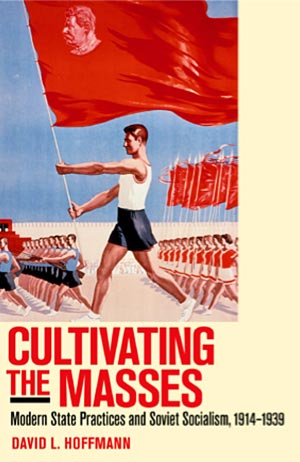
The Stalinist regime was among the most repressive and violent in all human history. Under Stalin’s leadership, the Soviet government carried out a massive number of deportations, incarcerations, and executions. Yet, paradoxically, at the very moment that the Soviet government was killing hundreds of thousands of people, it was engaged in an enormous pronatalist campaign to boost the population. Even as the number of incarcerations and executions grew exponentially, Communist Party leaders enacted sweeping social welfare and public health measures to safeguard people’s wellbeing. Extensive state surveillance of the population went hand-in-hand with literacy campaigns, political education, and efforts to instill in people an appreciation of high culture.
Cultivating the Masses examines the Party leadership’s pursuit of both “positive” and “negative” population policies in order to grasp fully the character of the Stalinist regime, a regime intent on transforming both the socio-economic order and the very nature of its citizens, and ready to employ unprecedented levels of social intervention to do so.
In this book, I analyze a range of social policies and present Soviet social intervention as one particular constellation of modern state practices—practices that arose in conjunction with ambitions to refashion society.
Soviet social policies reflected a new ethos by which state officials and nongovernment professionals sought to reshape their societies in accordance with scientific and aesthetic norms. This rationalist ethos of social intervention first arose in nineteenth-century Europe, and it subsequently prompted welfare programs, public health initiatives, and reproductive policies in countries around the world.
Social intervention intensified with the rise of mass warfare. The tremendous mobilizational demands of the First World War in particular impelled the leaders of all combatant countries to expand their use of economic controls, health measures, surveillance, propaganda, and state violence—all of which became prominent features of the Soviet system.
The Russian Revolution seemed to promise human liberation and equality. But instead it produced a Stalinist dictatorship, with extreme interventionism and unprecedented state violence. Why did a government purportedly dedicated to social harmony cause such enormous human suffering?
Conventional wisdom blames socialist ideology itself. This view sees the suppression of private property and the market economy under Soviet socialism as leading automatically to state violence. It is true that Marxism espoused violent proletarian revolution and the expropriation of the bourgeoisie as essential steps on the road to a communist utopia. But neither Marx nor Communist Party leaders invented the specific forms of state intervention and violence subsequently deployed by the Soviet government. These forms were borrowed from more general practices that developed in Europe, particularly during the First World War.
I first applied a comparative approach to Soviet history while working on my previous monograph, Stalinist Values: The Cultural Norms of Soviet Modernity, 1917-1941. One of the topics I researched for that book was Soviet family policy, in particular the Stalinist leadership’s efforts to strengthen familial obligations in the 1930s. Previously, scholars had seen Stalin’s efforts to buttress the family as part of his “Great Retreat” from revolutionary values in favor of more traditional institutions and culture. But when I began to look beyond the Soviet Union, I was struck by how countries throughout Europe and around the world in this period introduced similar policies to strengthen the family and increase the birthrate. I began to see Stalinist family policy as one particular manifestation of an international trend toward state attempts to manage reproduction.
In Cultivating the Masses, I place not only reproductive policies but Soviet welfare provision, public health, surveillance, and state violence in an international context. While I do not argue that the Soviet case was typical, or even a logical extreme, of the more general phenomenon of state interventionism, I do see it as an integral part of world history.
Through such an approach I seek to understand Soviet history not simply as a cautionary tale about socialism. Instead I argue that the Soviet system represented one particular response to the challenges of the modern era—particularly the challenges of mobilizing the population for industrial labor and mass warfare.
The purpose of my project is not to deny essential differences between the Soviet system and other modern states. A comparative approach permits me to highlight the distinctive as well as the common features of Soviet social policy. I seek to explain these differences through an analysis of the historically-conditioned particularities of the Soviet case. These particularities included Russian authoritarian traditions and Marxist-Leninist ideology, but they were not limited to them. Also significant were the social and political conditions in which pre-revolutionary Russian professionals developed their ideas and practices, borrowing from Western European thought but also drawing upon their particular concerns with uplifting the masses and battling the autocracy. I also explore the place of historical contingency in the development of the Soviet system. The Soviet system was formed at a moment of total war, and wartime institutions and practices of total mobilization became the building blocks of the new state and socio-economic order.
No discussion of Soviet social intervention would be complete without an examination of state violence. Indeed state violence, and the Gulag in particular, is frequently regarded as emblematic of the Soviet system as a whole. In 1937-1938 alone, according to official figures, the Soviet security police arrested 1,575,000 people, of whom it executed 681,692 and incarcerated another 663,308. By the end of 1940, the Soviet government had imprisoned over 1,930,000 people in Gulag labor camps, and these figures do not even include deportations of over one and a half million “kulaks” (wealthy peasants) to special settlements during the collectivization drive of the early 1930s. Soviet repression during this period amounted to an unprecedented scale of violence perpetrated by a state against its population.
Scholars have focused on Stalin’s motivations for ordering mass arrests and executions. But how was such violence possible or even conceivable? How was it implemented? How are we to characterize Soviet state violence under Stalin?
The primary form of Soviet state violence throughout the interwar period was excisionary violence—the forcible removal of specific segments of the population and the isolation or elimination of these groups. The purpose of excisionary violence, whether in the form of deportations, incarcerations, or executions, was to extract from society those deemed socially harmful or politically dangerous.
Excisionary violence did not originate in Russia, and it was not unique to Marxist regimes. Concentration camps were first developed in a colonial context and then were deployed throughout Europe itself during the First World War. In the Russian Civil War, the Soviet government (as well as the anti-Soviet, White armies) perpetuated the use of deportations and internments, and these practices became institutionalized within the Soviet system in the form of the Gulag.
I do not argue that techniques of social categorization and social excision in themselves caused Soviet state violence. Deportations, incarcerations, and executions carried out by the Soviet government were the result of decisions by Communist Party leaders, who acknowledged no limits on their authority and wielded unchecked, dictatorial power. Social cataloguing, technologies of social excision, and highly centralized bureaucratic and police apparatuses were all conditions of possibility for the forms of state violence enacted by Party leaders.
I thus present techniques of social categorization and excision as conceptual and practical preconditions of Soviet state violence, not as direct causes. These conceptual and practical preconditions occurred in other countries as well but, with certain exceptions such as Nazi Germany, did not result in massive state violence.
The direct cause of Soviet state violence was the Stalinist leadership’s ruthless determination to remove “kulaks” during collectivization and eliminate potential traitors prior to the Second World War. Stalin and his fellow leaders used pre-existing techniques of state violence to pursue their goals of revolutionary transformation and state security.
The Soviet case is frequently omitted from comparative historical analyses. Scholars tend to view the Soviet Union and its distinctive socio-economic order as anomalous and therefore fundamentally incomparable to other countries.
My examination of social policies, however, indicates the value of including the Soviet Union in such comparisons, as a means to highlight certain features of state interventionism and population management in the interwar period.
In particular, the Soviet case illustrates the connection between welfare and warfare. Welfare programs at this time were intended primarily to safeguard human resources and fulfill a set of reciprocal obligations between the state and its citizens. The Soviet health care system demonstrates how the rise of social medicine led to state-administered public health initiatives. It also provides an example of an authoritarian regime that adopted an environmentalist approach to maintaining its population’s bodily wellbeing. Soviet reproductive policies show that even a government as committed to social renovation as the Soviet regime could reject eugenics for disciplinary and ideological reasons, and could construct an essentialist gender order that nonetheless upheld women’s place in the workforce. The Soviet government’s extensive use of surveillance and propaganda confirms that in an era of mass politics, even authoritarian rulers felt compelled to monitor and influence people’s thinking. And in the area of state violence, the Soviet case reveals the lethal potentialities of techniques of social excision, particularly when wielded by a revolutionary dictatorship intent on achieving social transformation and state security.
Placing Soviet history in an international context also provides new perspectives on the Soviet system and allows us to move beyond explanations that attribute all aspects of Soviet social intervention to socialist ideology.
While Marxism-Leninism imparted to Party leaders both a set of social categories and a particular historical teleology, it did not provide a blueprint for their policies. I differ from those who see socialist ideology as a single, concrete program that, when put into practice, led inexorably to Stalinism.
Often coupled with a reified view of socialist ideology is its portrayal as a doctrine “out of step with reality”—an artificial attempt to reorder human society. My purpose in placing Soviet social policies in an international context is to illustrate that both the idea of social transformation and the technologies to pursue such a transformation in fact predated the Soviet system and were common to many ideologies and regimes of the twentieth century.


David L. Hoffmann is Professor of History at Ohio State University. He received his B.A. at Lawrence University and his M.A. and Ph.D. at Columbia University. Besides Cultivating the Masses, featured on Rorotoko, Hoffmann is the author of Peasant Metropolis: Social Identities in Moscow, 1929-1941 (1994) and Stalinist Values: The Cultural Norms of Soviet Modernity, 1917-1941 (2003), all by Cornell University Press, and the editor of Russian Modernity: Politics, Knowledge, Practices (Macmillan, 2000) andStalinism: The Essential Readings (Blackwell, 2002).